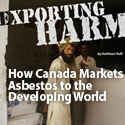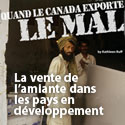The Critical Role Scientists And Health Professionals Can Play To Prevent Asbestos-Related Harm: Recent examples and lessons learned.
Kathleen Ruff, International Mesothelioma Interest Group (iMig) Conference, Cape Town, October 2014
ABSTRACT
Background
Evidence of harm caused by asbestos has been available for many decades. Yet the asbestos industry continues to place almost 2 million tons of asbestos every year in buildings and infrastructure in developing countries. For a century, Canada was a leading asbestos producer, exporter and propagandist. Scientists can play a key part in preventing a continuing epidemic of asbestos-related diseases. They have scientific credibility to challenge the industry’s misinformation and to demand evidence-based public health policy.
Methods
Together with human rights advocates and victims groups, scientists challenged Canada’s asbestos policy. They recognized that, when scientific evidence is distorted so as to endanger health, silence is not neutrality, it is complicity. They exposed the industry’s misinformation; they challenged the double standard whereby vulnerable populations overseas were being exposed to harm; they held policy makers, particularly those with a duty to protect health, accountable; they intervened in the public policy process; they shared their expertise with the larger public thus countering the lobbying efforts of vested interests.
Results
In a few short years, the asbestos industry lost political and public support. Consequently, in 2012, the Quebec government shut down the industry by cancelling a crucial loan.
Conclusions
Scientists and health professionals played a critical role in achieving this outcome. The asbestos industry has enormous financial resources. Scientists have, however, a responsibility to defend the integrity of science and public health policy. As the Canadian asbestos issue demonstrates, when scientists fulfill that responsibility, they can have significant impact in preventing harm.



Tue, Dec 9, 2014
Asbestos